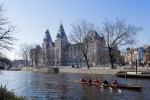 After 10 long, expensive years in which everything that could go wrong went wrong, the newly renovated Rijksmuseum will officially open its doors on April 13th. Anticipation has been building in the lead-up to the re-opening. Not even the rump museum, a group of 400 of the most important pieces from the 8,000-piece collection which have been on display in the Philips Wing over the past decade while the main building was being extensively rebuilt, has been available to whet appetites. It closed on March 18th so that staff could finish the final preparations for the grand opening.
After 10 long, expensive years in which everything that could go wrong went wrong, the newly renovated Rijksmuseum will officially open its doors on April 13th. Anticipation has been building in the lead-up to the re-opening. Not even the rump museum, a group of 400 of the most important pieces from the 8,000-piece collection which have been on display in the Philips Wing over the past decade while the main building was being extensively rebuilt, has been available to whet appetites. It closed on March 18th so that staff could finish the final preparations for the grand opening.
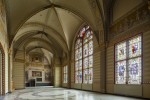 The last major painting — The Milkmaid by Johannes Vermeer — was rehung on Wednesday, April 3rd, and the international press were invited on a special tour of the shiny new museum on Thursday. On Saturday Queen Beatrix of the Netherlands will preside over the official opening. Twelve fanfares, one for every province, will greet the queen who will be given an individual tour of the building. At noon the official ceremony will take place in front of the main doors. After the ribbon-cutting, the public will be allowed admission free of charge until midnight. To ensure a steady flow of traffic, visitors on opening day will be taken on guided tours of the collection highlights.
The last major painting — The Milkmaid by Johannes Vermeer — was rehung on Wednesday, April 3rd, and the international press were invited on a special tour of the shiny new museum on Thursday. On Saturday Queen Beatrix of the Netherlands will preside over the official opening. Twelve fanfares, one for every province, will greet the queen who will be given an individual tour of the building. At noon the official ceremony will take place in front of the main doors. After the ribbon-cutting, the public will be allowed admission free of charge until midnight. To ensure a steady flow of traffic, visitors on opening day will be taken on guided tours of the collection highlights.
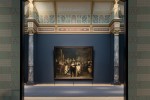 The highlight of the highlights is now and always has been Rembrandt’s The Night Watch. It was returned to its original position at the end of the Gallery of Honor, the only painting that will be on display in the same place architect Pierre Cuypers placed it when the Rijksmuseum first opened in 1885. The reason for this is that the building was basically designed around The Night Watch. It is framed by the architecture of the hall which leads the visitor to it. Rijksmuseum director Wim Pijbes noted at the press preview that “The Gallery of Honor is a kind of basilica that ends not with a Christian display, but a civilian display: Rembrandt’s Night Watch.”
The highlight of the highlights is now and always has been Rembrandt’s The Night Watch. It was returned to its original position at the end of the Gallery of Honor, the only painting that will be on display in the same place architect Pierre Cuypers placed it when the Rijksmuseum first opened in 1885. The reason for this is that the building was basically designed around The Night Watch. It is framed by the architecture of the hall which leads the visitor to it. Rijksmuseum director Wim Pijbes noted at the press preview that “The Gallery of Honor is a kind of basilica that ends not with a Christian display, but a civilian display: Rembrandt’s Night Watch.”
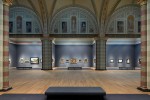 That was Cuypers’ vision for the museum: a secular cathedral for the arts with The Night Watch, this huge baroque 12-by-15-foot masterpiece celebrating not religious figures or great historical events, but rather Dutch burghers in a volunteer civic militia, as its high altar in the exact center of the museum. The elegant architectural features — soaring multi-story halls, columns, vaults, marble mosaic flooring, stained glass windows, elaborate frescoes — were meant to imbue the space with the feeling of a cathedral dedicated to Dutch culture and history rather than to religion.
That was Cuypers’ vision for the museum: a secular cathedral for the arts with The Night Watch, this huge baroque 12-by-15-foot masterpiece celebrating not religious figures or great historical events, but rather Dutch burghers in a volunteer civic militia, as its high altar in the exact center of the museum. The elegant architectural features — soaring multi-story halls, columns, vaults, marble mosaic flooring, stained glass windows, elaborate frescoes — were meant to imbue the space with the feeling of a cathedral dedicated to Dutch culture and history rather than to religion.
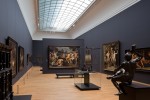 This vision fell out of favor in the 20th century, and between the 1920s and the 1950s, the walls were whitewashed. During this period, authorities didn’t want the cathedral at all, even a secular one, but a stripped down modernist museum. Part of this phase of rebellion against the cathedral museum was moving the high altar out of its dramatic central position. The Night Watch was shifted to different locations around the building. None of them worked well as should have come as a surprise to no one given its colossal size and dark chiaroscuro which requires a specific lighting plan to be seen to its best advantage.
This vision fell out of favor in the 20th century, and between the 1920s and the 1950s, the walls were whitewashed. During this period, authorities didn’t want the cathedral at all, even a secular one, but a stripped down modernist museum. Part of this phase of rebellion against the cathedral museum was moving the high altar out of its dramatic central position. The Night Watch was shifted to different locations around the building. None of them worked well as should have come as a surprise to no one given its colossal size and dark chiaroscuro which requires a specific lighting plan to be seen to its best advantage.
 When renovations began in 2003, The Night Watch was moved to yet another temporary location which ended up being its home for 10 years. On Thursday, March 27th, a climate-controlled crate, cranes, dozens of workers and police lifted it out of the Philips Wing and into the Gallery of Honor. To celebrate its return, Dutch financial company ING sponsored what may be the coolest of all flashmobs. Thirty-four people in 17th century outfits rode horses and rappelled from ropes into the middle of a shopping center in Breda and recreated The Night Watch as a tableau vivant. Behold:
When renovations began in 2003, The Night Watch was moved to yet another temporary location which ended up being its home for 10 years. On Thursday, March 27th, a climate-controlled crate, cranes, dozens of workers and police lifted it out of the Philips Wing and into the Gallery of Honor. To celebrate its return, Dutch financial company ING sponsored what may be the coolest of all flashmobs. Thirty-four people in 17th century outfits rode horses and rappelled from ropes into the middle of a shopping center in Breda and recreated The Night Watch as a tableau vivant. Behold:
[youtube=http://youtu.be/a6W2ZMpsxhg&w=430]
I need to go shopping more. In the Netherlands.
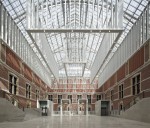 The new Rijksmuseum has been returned to its former cathedral splendor but with state-of-the-art lighting, climate control, security and technology. All of the original wall paintings were recreated since most of them could not be recovered. At the same time, architects Cruz y Ortiz have created a new Atrium, a lofty light-filled glass entrance hall to welcome visitors. The design of the galleries is also completely new, from display cases to furniture to the organization of the exhibits. No longer are they grouped by kind — glass, ceramics, paintings — but rather by era. That means paintings and ceramics and glass and wood will all be seen together, telling the story of the Netherlands chronologically from the Middle Ages to the 20th century.
The new Rijksmuseum has been returned to its former cathedral splendor but with state-of-the-art lighting, climate control, security and technology. All of the original wall paintings were recreated since most of them could not be recovered. At the same time, architects Cruz y Ortiz have created a new Atrium, a lofty light-filled glass entrance hall to welcome visitors. The design of the galleries is also completely new, from display cases to furniture to the organization of the exhibits. No longer are they grouped by kind — glass, ceramics, paintings — but rather by era. That means paintings and ceramics and glass and wood will all be seen together, telling the story of the Netherlands chronologically from the Middle Ages to the 20th century.